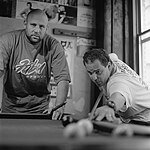Hammerstein Ballroom
1906 establishments in New York CityBallrooms in ManhattanBoxing venues in New York CityCulture of ManhattanEsports venues in New York (state) ... and 8 more
Extreme Championship WrestlingHell's Kitchen, ManhattanMusic venues completed in 1906Music venues in ManhattanNew York ExcelsiorOpera houses in New York CitySports venues in ManhattanTheatres in Manhattan

The Hammerstein Ballroom is a 12,000-square-foot (1,100 m2) ballroom located within the Manhattan Center at 311 West 34th Street in Midtown Manhattan, New York City. The capacity of the ballroom is dependent on the configuration of the room; it seats 2,500 people for theatrical productions and musical performances, and several thousand for events held within a central ring. The floor of the ballroom is flat. The two main balconies – which are unusually close to the ground and gently sloped – seat a total of 1,200. The third balcony has been stripped of seats and is not used.
Excerpt from the Wikipedia article Hammerstein Ballroom (License: CC BY-SA 3.0, Authors, Images).Hammerstein Ballroom
West 34th Street, New York Manhattan
Geographical coordinates (GPS) Address Phone number Website Nearby Places Show on map
Geographical coordinates (GPS)
| Latitude | Longitude |
|---|---|
| N 40.752908 ° | E -73.994189 ° |
Address
Manhattan Center (Hammerstein Ballroom)
West 34th Street 311
10001 New York, Manhattan
New York, United States
Open on Google Maps








